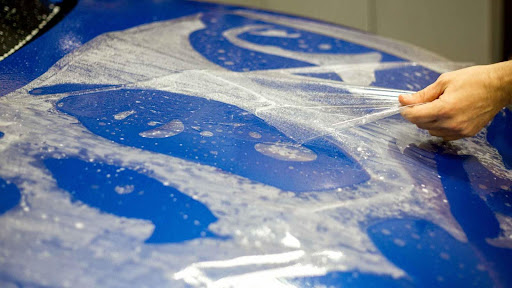Owning a car is a big responsibility, not only in terms of driving and maintaining it but also ensuring that its aesthetic appeal and value remain intact. One of the most frustrating experiences for a car owner is seeing small chips, scratches, and dings accumulate over time. These imperfections, caused by everyday hazards such as road debris, weather, and environmental pollutants, not only hurt the visual appeal of your car but can also lead to expensive repairs if not properly addressed.
Fortunately, there’s a solution to avoid these repairs and keep your car in pristine condition: Paint Protection Film (PPF). In this blog, we’ll explore how PPF works as a protective layer for your car, saving you from expensive repairs and preserving your vehicle’s look and value.
What Is Paint Protection Film (PPF)?
Paint Protection Film (PPF) is a transparent, self-healing layer that’s applied to a car’s exterior. Made from a durable polyurethane material, it shields the vehicle’s paint from everyday damage caused by road debris, minor scratches, bird droppings, tree sap, UV rays, and more. The film is virtually invisible once applied, so it does not alter the vehicle’s appearance, but it offers an additional layer of protection that acts like an invisible armor for your car.
PPF is designed to absorb the impact of various physical forces that could damage your car’s paint. Whether you are driving through a construction zone with loose gravel or parking in a tight spot, the film ensures that any damage to your vehicle’s paint is minimized.
Everyday Hazards That Lead to Paint Damage
Several hazards on the road and during daily use of your vehicle can lead to costly paint damage. Here are the main culprits:
1. Stone Chips and Road Debris
The primary source of paint damage comes from road debris. Stones and pebbles kicked up by other vehicles or loose gravel can chip away at your car’s paint. While these chips might seem minor at first, over time they can lead to deeper damage, rust formation, and a dull appearance.
2. Environmental Pollutants
Bird droppings, tree sap, and other pollutants can cause irreversible damage to your vehicle’s paint if left untreated. These substances can etch into the paint and leave stains, leading to the need for professional touch-ups and even repainting in extreme cases.
3. Scratches from Parking and Everyday Activities
Whether it’s a grocery cart brushing up against your car, an accidental scratch from a tree branch, or even the bump of a neighboring car in a tight parking spot, scratches can easily occur. These can become unsightly over time and may require expensive professional repair.
4. UV Damage
Long-term exposure to UV rays can cause a car’s paint to fade, dull, and lose its gloss. UV damage may not be immediately noticeable, but over the years, it degrades the paint, necessitating costly repairs and repainting to restore the car’s original shine.
How PPF Helps Prevent Expensive Repairs
Paint Protection Film helps in multiple ways to prevent the need for costly repairs by acting as a barrier between your car’s paint and the damaging elements. Here’s how PPF provides protection:
1. Protection from Stone Chips and Road Debris
The high-quality polyurethane film absorbs the impact from small stones and debris, preventing them from causing chips and scratches. The film takes the brunt of the damage, which would otherwise be absorbed by the car’s paint. This reduces the frequency and severity of paint repair jobs.
2. Prevents Scratches and Minor Dings
The transparent film acts as a barrier against scratches from everyday use. Whether it’s a minor bump or a shopping cart scratch, PPF absorbs and deflects damage, leaving the paint underneath unscathed.
3. Self-Healing Technology
One of the most impressive features of PPF is its self-healing ability. Minor scratches and swirl marks that occur on the surface of the film can disappear when exposed to heat. This feature keeps the film looking fresh and undamaged, which also helps preserve the car’s original paint beneath.
4. Protection from Environmental Damage
Bird droppings, tree sap, and other contaminants are no match for PPF. The film provides an effective shield against these substances, making them easier to clean off and preventing the risk of permanent damage to the vehicle’s paint.
5. UV Protection
PPF is equipped with UV inhibitors, which block harmful UV rays from fading and discoloring your car’s paint. This means that the car’s exterior retains its glossy and vibrant look, extending the life of your vehicle’s paint job.
Why You Should Consider PPF to Save on Repairs
While the initial cost of applying PPF may seem like an investment, it is an investment that pays off over time. By protecting your vehicle’s paint, PPF helps you avoid the need for costly bodywork, touch-ups, or repainting. The film helps maintain the car’s value, ensuring it looks as good as new for years to come. Whether you plan to keep your car for the long haul or sell it in the future, PPF ensures that the exterior remains flawless, saving you money in the long run.
Conclusion
PPF offers a practical solution to everyday wear and tear, preventing costly repairs caused by road debris, scratches, bird droppings, UV damage, and environmental contaminants. For car owners who want to maintain their vehicle’s aesthetic appeal, extend its lifespan, and avoid expensive repair bills, investing in PPF is a smart move.
If you’re in Orlando and want to protect your car from everyday hazards while keeping it looking great, consider PPF Orlando. This invisible protective layer acts as a shield against the elements, ensuring that your vehicle remains in top condition. Explore the PPF options available to you and see how it can provide peace of mind and preserve your vehicle’s exterior for the long term.




